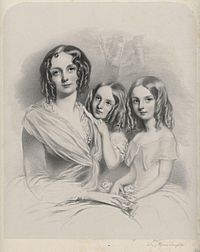Anna Thynne facts for kids
Quick facts for kids
Anna Thynne, Lady John Thynne
|
|
|---|---|

Anna Thynne with her daughters Selina and Emily
|
|
| Born |
Anna Constantia Beresford
1806 Walford, Waterford, Ireland
|
| Died | 22 April 1866 |
| Nationality | British |
| Citizenship | British |
| Known for | marine zoology |
| Spouse(s) | Lord John Thynne (1798–1881) |
| Scientific career | |
| Fields | zoology |
Anna Constantia Thynne, Lady John Thynne (born Beresford; 1806–1866) was a British scientist. She was a pioneer in the study of marine animals, known as a marine zoologist. In 1846, she built the very first successful and long-lasting marine aquarium. She managed to keep corals and sponges alive in it for more than three years.
Contents
Discovering the Ocean's Wonders
Anna Thynne first loved studying rocks and the Earth, a field called geology. But in 1846, she found something amazing: a "Madrepore." This was a type of stony coral that looked like a rock but was actually a living creature. She was fascinated by it.
Bringing Sea Life Home
Anna wanted to bring these sea creatures back to London from Torquay. She carefully attached the Madrepores to a sponge using a needle and thread. She placed them inside a stone jar for the journey.
Once home, she moved them to a glass bowl. At first, she changed the water every other day. But getting fresh seawater was hard. So, she found a new way to keep the water healthy.
Creating a Balanced Aquarium
Anna started moving the water between different containers. She did this in front of an open window. This process helped add air to the water, just like waves do in the ocean. This was a clever way to "aerate" the water.
In 1847, she added marine plants to her bowls. These plants helped keep the water clean and balanced. After two years, she had created the world's first truly balanced marine aquarium. This meant the plants and animals could live together in a healthy environment.
Her Lasting Impact
Anna Thynne's amazing work inspired many others. One important person was Philip Henry Gosse. He used her ideas to create the "Fish House" at the London Zoo in 1853. This became one of the first public aquariums. Her efforts showed that it was possible to keep marine life alive and healthy outside the ocean.
About Her Family Life
Anna Thynne was married to Lord John Thynne (1798–1881). He was a church leader, a Canon and Sub-Dean, at Westminster Abbey. He was also the third son of a nobleman, Thomas Thynne, 2nd Marquess of Bath. Because of her marriage, she was known as "Lady John Thynne."
See also
 In Spanish: Anna Thynne para niños
In Spanish: Anna Thynne para niños

